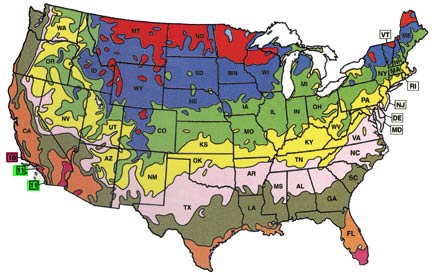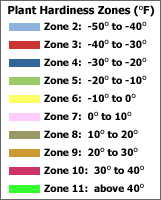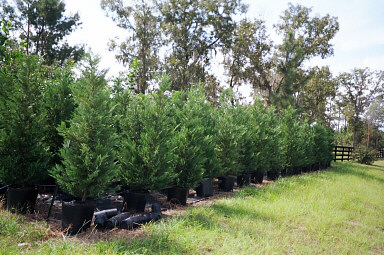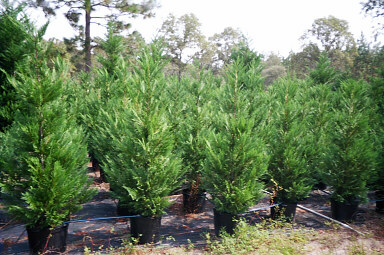Soil Types for Leyland Cypress Trees
Planting Leyland Cypress Trees
Fertilizing Leyland Cypress Trees
Shearing Leyland Cypress Trees
Insect Problems with Leyland Cypress Trees
Diseases of Leyland Cypress Trees
Leyland Cypress is a rapid growing conifer averaging three or more feet per year. Its rapid growth makes this tree ideal for hedges, windbreaks, and Christmas tree production. Its overall vigor makes this tree very easy to grow. This being said each year I receive many questions regarding the Leyland. This article hopefully will answer most of these questions.
Soil Types – Leyland Cypress; Leyland Cypress grows well in a wide range of soils, ranging from all sand to pure Georgia red clay. In soils with a PH of 5.0 to 8.0, however best growth falls between 5.5 and 6.5. When PH falls below 5.0 food intake is greatly reduced, lime or wood ashes should be applied. PH above 7.0 and minor elements or trace minerals are not as available to the tree. Sulfur or acid fertilizers should be used. Iron sulfate or magnesium sulfate (Epson Salts) will also help to lower Ph. Both are excellent for deep green color. When planting in very sandy soils adding organic matter is recommended to improve the soils ability to hold water and nutrients. When planting in hard clay soils, its best to dig the hole several feet deep and fill with soft loam soil to give the young tree a faster, more aggressive root system. Also the deeper hole helps with drainage. Leylands prefer well drained soils but will tolerate the opposite. Number one problem in clay soils is a young tree is planted in a shallow hole, rains fill the hole, where water stands for long periods of time. Causing the roots to rot and the tree dies. Many people are confused with the name cypress. Leylands are in the family of false cypresses, with no relationship to the Bold Cypress that grows in the southern swamps. Leylands should never be planted in soils that are excessively wet for long periods of time. Since the leylands have a shallow root system, weeds and grass growing around the tree will bring the tree growth to a standstill. Using plastic ground cover, sold in most landscape stores, and mulching, will improve your growth three fold. Not only stopping weeds and grass, it will hold soil moisture and maintain a lower more even soil temperature, stimulating more aggressive root growth.
Planting – Never plant trees deeper than originally planted. Doing so can cause rotting of the stem and death to the tree. In areas of dry weather drip irrigation is recommended. Leyland are very drought tolerant, however they grow very slow without adequate water. Staking young trees is recommended, heavy rain, wind can cause trees to fall on to the ground, allowing bacteria and fungus to attack the young tree, causing injury or death. When tying trees to stakes remember the tree will continue to grow. Loosely tie the tree with several twist ties to allow for growth. Check trees every three months and loosen as needed. If this is not done, the twist tie will grow into the tree causing injury. After strong storms or hurricanes large leylands may be bent over. If the tree can be stood back up you will need to stake the tree. You can use four 61/2 ft to 8 ft metal fence posts. Run wire around the upper part of the tree, best to run the wire thru a piece of hose to prevent rubbing the bark off the trunk, and loop the wire back to the post. Now you have two wires running alongside each other. Use a long screw driver to twist the two wires together, pulling the lines tight. Start first with the side you need to pull the tree towards the most. Then follow with each of the other stakes. A large tree will need anywhere from six months to one year to reestablish itself. The one question that comes up often, “when is the best time to plant.” For the most part, container trees can be planted year around, provided the ground isn’t frozen. The exception is planting liners, (nursery term for a tree that is reproduced by propagation) Young Leyland Cypress liners cannot withstand as much cold as older more mature trees. As a rule 8 to 10 degrees is their limit. Older trees can withstand temperatures of 0 degrees, maybe as low as – 10 degrees. From lower Virginia and north to New York, plant liners in early spring, starting in mid March to early April to as late as early November. Older trees can be planted until the ground freezes. I personality prefer planting early enough for the tree to become established before going into winter. This takes four to eight weeks. All growth and root development stop when soil temperatures drops below 50 degrees. Below Virginia many nurseries and Christmas tree growers field plant year around, weather permitting, with container planting waiting till warmer weather approaches. When planting a potted tree, remember the only water source the tree has, is its small root ball, and all the water the tree uses must come from there until new roots can grow into the surrounding soil. New trees should be watered twice weekly, under hot conditions possibly more. Care should be taken not to over water. More trees die from over watering than under.
Fertilizing Leyland Cypress – Anyone who has been to a garden center or looked through a nursery catalog has come to realize the enormous amount of different fertilizers there are for sale. This confuses many of the most experienced growers. I can only imagine how the average homeowner feels. To simplify this I’ll break down fertilizer into four categories, Garden, Time Release, Water Soluble, and Organic. Garden fertilizer is the cheap fertilizer you find being sold everywhere from your local garden center to your local grocery store. The 50lb bags have the numbers 6-6-6, 8-8-8, or 10-10-10 in large print and lawn fertilizer 16-4-8. I personally have nothing good to say about this type of fertilizer. The nitrogen source is very caustic and can severely injure or kill your trees. After applying this type of fertilizer you will see any damage occurring in less than 7 days, and there is very little you can do. The overall best fertilizer you can use is Time Release. This means just what it says, the nutrients are released over a long period of time. For short term crops, bedding plants or garden plants, a 3 month release is good, but for trees and especially Leyland Cypress look for 8 to 9 month release or even a 12 to 14 month. Apply in early spring and your trees will have the proper nutrients all year. Water soluble fertilizers are powders that dissolve in water. This type of fertilizer are very mild and non-burning. They are marketed under many names, the most common are Peters, and Miracle Grow. The nutrients are readily available to plants, also its very hard to over fertilize and injure your trees, however it must be applied once or twice per month during the growing season. Organic fertilizers are derived from organic sources. Manure, sludge, fish emulsion, kelp or seaweed, dried blood, the list is almost endless. This group of fertilizers are for the most part very safe and beneficial to use. I recommend using this type of fertilizer with both Time Release and Water Soluble. The main reason for this, organic fertilizers will increase microbial activity in the soil. These microbes convert different types of nitrogen into a usable form for plants. I myself like Fish Emulsion, it contains all the nutrients, trace minerals, amino acids, and enzymes. Its one of the most complete fertilizers on the planet. When first planting a young tree, your first concern is to establish a well developed root system. Root stimulators are fertilizers that contain lower amounts of nitrogen, higher amounts of phosphorous, and lower amount of potassium, plus a rooting hormone. Using a root stimulator can easily save weeks in establishing a new tree and will greatly improve the trees vigor and overall health. After your tree is established choose a fertilizer for growth. This fertilizer will contain higher amount of nitrogen, phosphorus, and potassium and always buy fertilizers with trace minerals, also called minors. (example: 18-8-8 plus minors).
Shearing Leyland Cypress is easy and an excellent way to control the trees size. For a formal hedge start shearing when the tree reaches 3 or 4 feet in height, cutting only the sides, remove no more than 3 or 4 inches of growth. This will cause the tree to grow thicker. If you want the tree to grow tall don’t cut the top leader, just shape the sides. The best time to shear is after a new growth spurt finishes and the new growth begins to mature. Growth will go from a smooth, greasy texture, to a more rough snake skin look. Shearing twice a year is sufficient. To keep your trees at a particular height requires cutting the central leader and then shearing all outside branches. this will control the tree for many years, but in time the tree will become to large to maintain. After shearing its wise to spray your trees with a fungicide every 7 to 10 days for at least 6 weeks. The reason for this is conifers produce much of there food in strong, active growing tips. Shearing temporarily reduces the amount of food being produced, weakening the tree, this could result in a fungal infection. The old adage is an ounce of prevention is worth a pound of cure. Use Kocide 2000. (active ingredient, copper hydroxide )
Insect problems with Leyland Cypress – Leyland Cypress only have a few insects that cause any real problems. Bagworms are probably the worst, on small trees Bagworms can be picked by hand but larger trees need to be sprayed. Dimethoate which sells under the trade name Cygon, works well when applied in the first 3 months of spring, when the larvae are small and before they produce bags. After they produce bags they are very difficult to control with chemicals. Scale is another insect that attacks Leylands, they look like little crusty flakes covering the needles and branches. Scale feed on sap causing a chlorosis (yellow) look to the needles. Cygon is a systemic insecticide that is very effective aganist scale. Systemic means it enters into the tree, the scale feed on the sap and dies. As with Bagworms, spring is a good time to spray for prevention. The most difficult insect to control on Leylands is Spider Mites. These are very small insects that can be seen with a magnifying glass. Feeding on the sap needles turn yellow and later brown. Spidermites have become resistant to most of the old chemicals. Recommend using only true miticides for control.
Diseases Of Leyland Cypress There are only four main diseases of Leyland Cypress, Seiridium canker or stem canker, causes branches and entire trees to die. No effective chemical control available. A mixture of Zertol and Daconil may help. Botryosphaeria canker is similar to Seiridium canker causes entire branches to die. No effective chemical control available, a mixture of Zerotol and Daconil may help. Cercosporidium Blight is a very aggressive fungi. Spores are airborn and travel very fast. Needles turn yellow and drop, usually starting on lower branches, starting from the inside and progressing outward and upward. Kocide 2000 works well at controling this fungi. Using Zertol in a rotation with Kocide 2000 can be curative. Cercosporidium usually attacks trees that have been stressed from shearing, drought, lack of fertilizer, and hot sun. It almost always starts on the sunny side of the tree. The last disease is Phytophthora root rot. This disease occurs with trees having poor drainage, or that have been over watered, and is not generally a large problem. Zertol is very effective. Zerotol is available online or can be ordered thru your local nursery. However the smallest size available is in 21/2 gallon containers of concentrate making between 400 to 1280 gallons of finished solution. Zertol in concentrated form is a very corrosive oxidizer, carrying haz-mat warnings. As with all chemicals read and follow all instructions.





